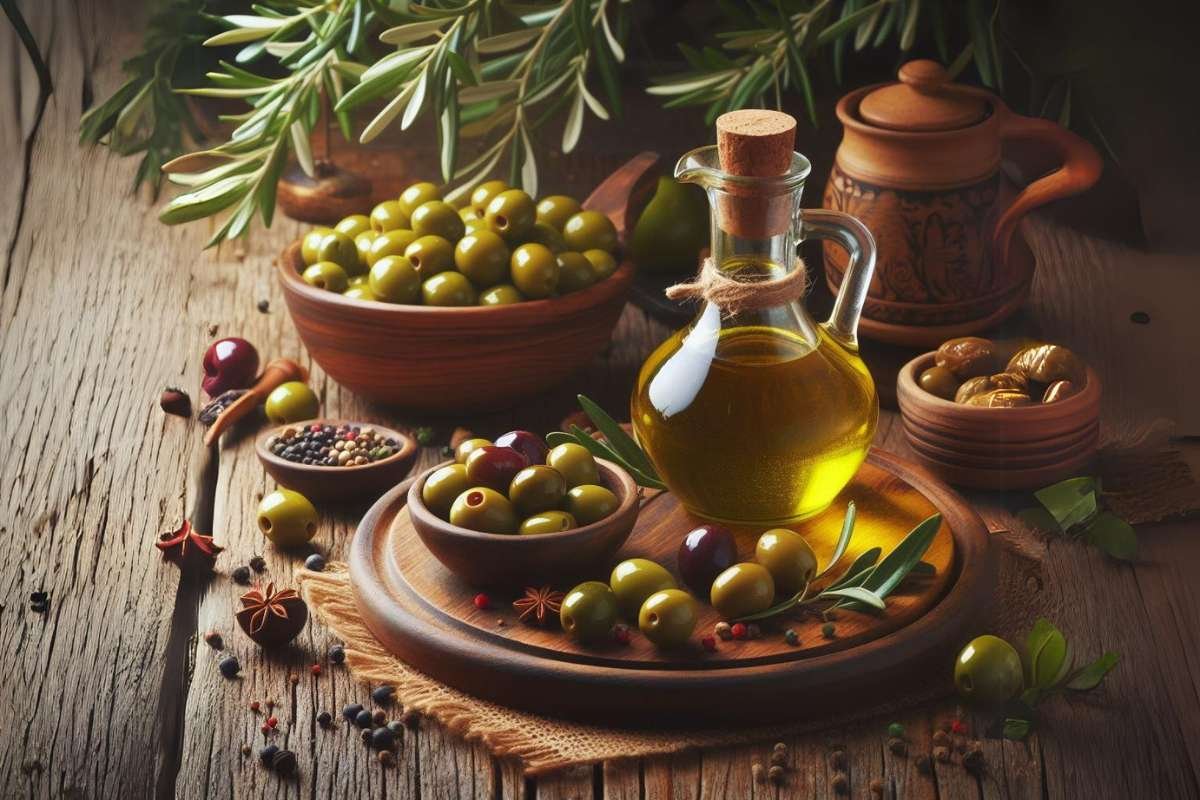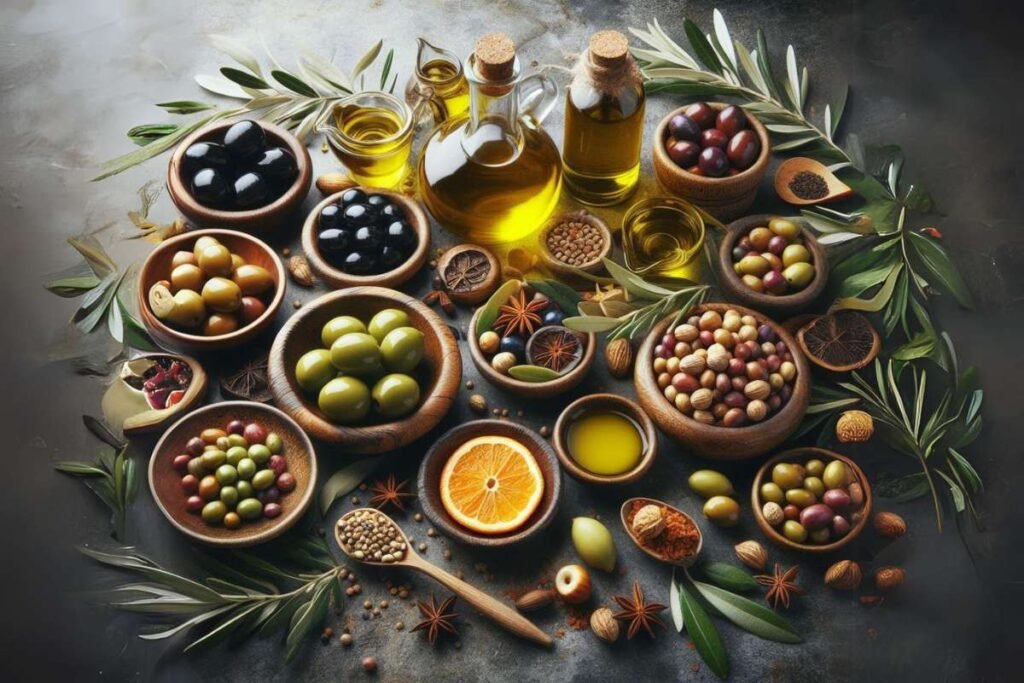Polyphenols in Olive Oil: The Ultimate Guide

Olive oil has been celebrated for centuries, not just for its culinary versatility but also for its remarkable health benefits. A significant contributor to these benefits is a group of compounds called polyphenols.
These natural antioxidants have been linked to various positive effects on our bodies, from heart health to potential anti-cancer properties.
In this article, we’ll delve into the world of polyphenols in olive oil, exploring their types, benefits, and how to choose the best olive oil for optimal health.

What are Polyphenols?
Polyphenols are micronutrients found in many plant-based foods, including fruits, vegetables, tea, coffee, and of course, olives. They act as antioxidants, protecting our cells from damage caused by harmful molecules called free radicals.
This damage, known as oxidative stress, is a key factor in the development of chronic diseases like heart disease, cancer, and neurodegenerative disorders.
Polyphenols in Olive Oil: A Unique Combination
Olive oil stands out for its particularly rich and diverse array of polyphenols. There are over 30 different types found in olive oil, each with unique properties and potential health benefits. Some of the most notable polyphenols in olive oil include:
- Hydroxytyrosol: This potent antioxidant has been shown to protect blood vessels, lower blood pressure, and reduce inflammation.
- Oleocanthal: Known for its peppery taste, oleocanthal has anti-inflammatory effects similar to ibuprofen.
- Oleuropein: This compound is responsible for olive oil’s bitter flavor and has been linked to improved heart health and blood sugar control.
- Tyrosol: Another powerful antioxidant, tyrosol may help protect against heart disease and certain types of cancer.
The Health Benefits of Polyphenol-Rich Olive Oil
Research suggests that consuming olive oil with high polyphenol content may offer a wide range of health benefits, including:
- Cardiovascular Health: Polyphenols in olive oil have been shown to lower bad cholesterol (LDL), increase good cholesterol (HDL), and reduce blood pressure, all of which contribute to a healthier heart.
- Anti-inflammatory Effects: Oleocanthal, in particular, has potent anti-inflammatory properties that may help manage conditions like arthritis and inflammatory bowel disease.
- Brain Health and Neuroprotective Properties: High phenolic compounds in olive oil have been found to exhibit neuroprotective properties, helping to preserve cognitive function and reduce the risk of neurodegenerative diseases such as Alzheimer’s and Parkinson’s.
- Cancer Prevention: Some polyphenol compounds have demonstrated anti-cancer effects in laboratory studies, although more research is needed in humans.
- Blood Sugar Control: Olive oil polyphenols may improve insulin sensitivity and help regulate blood sugar levels, making it beneficial for individuals with diabetes or at risk of developing it.
Side Effects of Polyphenols in Olive Oil
While polyphenols are generally considered safe, there are some potential side effects to be aware of:
- Astringency: Some people may experience astringency, a sensation of dryness or puckering, when consuming high-polyphenol olive oils.
- Bitterness: Polyphenols can also contribute to the bitterness often associated with high-quality olive oils.
- Pungency: The stinging sensation in the throat, often referred to as pungency, can be intense in some high-polyphenol olive oils.

Choosing the Best Olive Oil for Polyphenols
Not all olive oils are created equal when it comes to polyphenol content. Several factors influence the levels of polyphenols in olive oil:
- Olive Variety: Some olive cultivars naturally have higher polyphenol levels than others.
- Harvesting Time: Early harvest olives tend to have more polyphenols.
- Processing Methods: Cold-pressed and unfiltered olive oils retain more polyphenols than those processed with heat or filtration.
- Storage Conditions: Olive oil should be stored in a cool, dark place to preserve its polyphenol content.
How to Identify High-Polyphenol Olive Oil
Look for the following on labels to identify olive oils likely to be high in polyphenols:
- Extra Virgin Olive Oil (EVOO): This is the highest quality olive oil, produced without heat or chemicals, and typically has more polyphenols.
- Harvest Date: Choose olive oils from early harvests.
- Unfiltered or Lightly Filtered: These oils retain more of the polyphenol-rich sediment.
- Statements about Polyphenol Content: Some brands may specifically mention high polyphenol levels on their labels.
- Certified High-Phenolic Olive Oil: Look for certifications like the EU Health Claim Regulation, which requires a minimum level of polyphenols for the claim.
Top 7 Olive Oils Rich in Polyphenols for 2024
Here is a list of the top 5 olive oils rich in polyphenols for 2024, based on various sources and expert recommendations:
- Frantoio Olive Oil: This Italian olive oil is known for its robust flavor and high polyphenol content, making it an excellent choice for cooking and as a finishing oil
- Coratina: This olive variety is known for producing EVOOs with a high polyphenol count. Look for brands specializing in Coratina olives.
- Arbequina: While known for its milder flavor, some Arbequina EVOOs can be rich in polyphenols. Look for brands mentioning high-phenolic content.
- Picual: Hailing from Spain, Picual olives often produce EVOOs with a peppery flavor and significant polyphenol content.
- California Olive Ranch (COR): This California-based brand offers EVOOs with high polyphenol content, often exceeding the 250mg/kg benchmark. Manni Extra Virgin Olive Oil (Organic): This organic EVOO boasts a high polyphenol content, making it a healthy and flavorful choice.
- Kirkland Signature Extra Virgin Olive Oil: This budget-friendly option from Costco is a great value for its high-quality, extra-virgin oil
- Brightland Alive 100% Extra Virgin Olive Oil: This California-sourced olive oil features the harvest date on its website, ensuring freshness and high polyphenol levels
Incorporating Polyphenol-Rich Olive Oil into Your Diet
The simplest way to enjoy the benefits of polyphenols in olive oil is to use it generously in your daily cooking.
While high-phenolic EVOO offers incredible health benefits, its lower smoke point (the temperature at which it starts to break down) means it’s not ideal for high-heat cooking methods like frying. Here’s where it shines:
- Marinades: Marinate meats, fish, and tofu in high-phenolic EVOO to add flavor and potentially enhance their antioxidant profile.
- Low-Heat Cooking: Use high-phenolic EVOO for low-heat cooking methods like sauteing, poaching, and simmering.
- Drizzling: Drizzle high-phenolic EVOO on salads, vegetables, soups, pasta dishes, and bread for a burst of flavor and a healthy dose of polyphenols. Here is a quick and simple recipe of pasta using EVOO

Simple Aglio e Olio Pasta with Burst Cherry Tomatoes
Ingredients
- pound dried spaghetti or your favorite pasta
- ½ cup high-quality extra virgin olive oil EVOO, high in polyphenols (if possible)
- 6 cloves garlic thinly sliced
- 1 pint cherry tomatoes halved
- ½ teaspoon red pepper flakes optional
- ¼ cup chopped fresh parsley
- Salt and freshly ground black pepper to taste
- Grated Parmesan cheese for serving (optional
Instructions
- Cook the Pasta: Bring a large pot of salted water to a boil. Add the pasta and cook according to package directions, aiming for al dente (slightly firm to the bite). Reserve about 1 cup of the pasta water before draining.
- Infuse the Oil: While the pasta cooks, heat the EVOO in a large skillet over medium-low heat. Add the sliced garlic and cook gently for 1-2 minutes, until fragrant and lightly golden. Be careful not to brown the garlic, as it can become bitter.
- Introduce the Tomatoes: Add the halved cherry tomatoes to the pan with the infused EVOO and garlic. Increase the heat to medium and cook for 2-3 minutes, allowing the tomatoes to soften and release their juices.
- Spice it Up (Optional): If you prefer a bit of heat, add the red pepper flakes at this stage and cook for another minute.
- Unite the Dish: Once the pasta is cooked, drain it, reserving some of the pasta water. Add the cooked pasta directly to the skillet with the tomato mixture. Toss everything together to coat the pasta evenly.
- The Finishing Touches: Gradually add some of the reserved pasta water, a tablespoon at a time, until the sauce reaches a desired consistency – slightly creamy and coating the pasta. Season with salt and freshly ground black pepper to taste.
- Serve and Enjoy: Plate the pasta and garnish with chopped fresh parsley. Top with grated Parmesan cheese, if desired. Serve immediately and savor the simplicity and health benefits of this EVOO-centric dish.
Notes
- Use high-quality EVOO with a peppery flavor to truly experience the polyphenol punch.
- For a richer taste, reserve a tablespoon of pasta water before adding the tomatoes. Mix it with a tablespoon of grated Parmesan cheese to create a simple, flavorful sauce for the pasta.
- Leftovers can be stored in an airtight container in the refrigerator for up to 2 days. Reheat gently in a pan with a splash of olive oil or pasta water to prevent drying out.
You may also check other exciting pasta recipes by us
FAQs About Polyphenols in Olive Oil
Conclusion
Polyphenol-rich olive oil is a true superfood, offering a wealth of potential health benefits. By understanding the types of polyphenols, their benefits, and how to choose the right olive oil, you can unlock the full potential of this ancient elixir and enjoy a healthier, longer life.
We’ve explored the world of polyphenols in olive oil, but the journey doesn’t end here! Share your questions and insights about these powerful antioxidants in the comments below. Let’s create a conversation about incorporating healthy fats into our diets.






